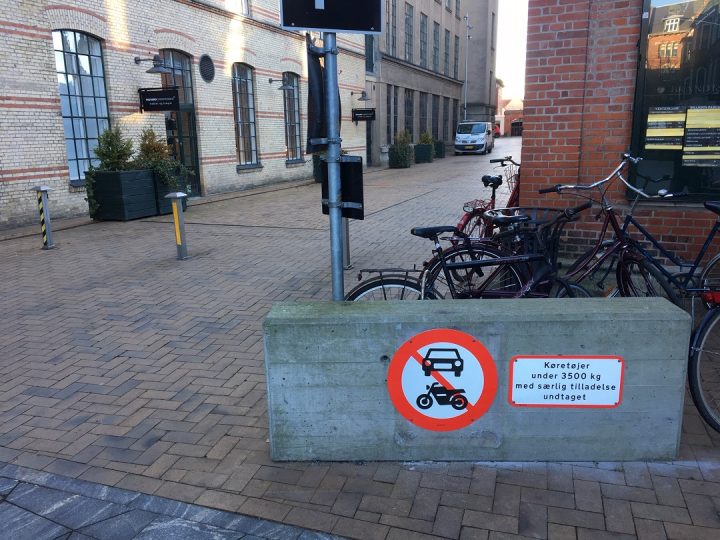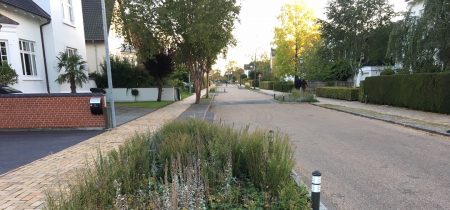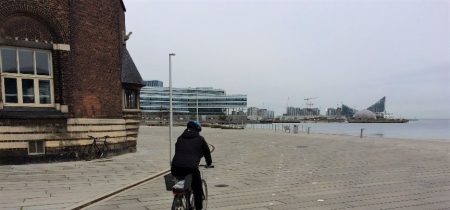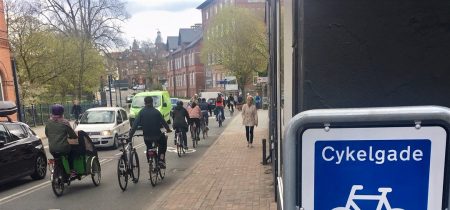Regulating motor traffic
Motor traffic can be regulated with a view to cyclist safety and accessibility. Roads can be closed off, sometimes with automatic gate control, and shunts can be created for busses and cyclists. Placement of car parking and deliveries should also take account of cyclist needs.
By Troels Andersen
Permanent road closure
Roads are closed off in Denmark primarily in order to prevent through-going traffic. Road closure is increasingly being used to reduce the total volume of motor traffic in city centers and to improve traffic safety. When urban areas are divided into zones through road closure, short car trips become less attractive.
Road closure is most often carried out in connection with intersections, for example when fewer legs are desired. However, cars need to turn on one or both sides of the road closure, which poses a design challenge. To forestall turning maneuvers the dead end sign should be prominently displayed.
Cyclists should be able to cycle through a road closure easily since road closure rarely applies to cyclists. Cyclists should be able to cycle through two openings, each 1.3-1.4 m wide. However, widths narrower than 1.60 typically mean that sweeping and snow clearance must be carried out manually. One option is to establish cycle shunts next to each other with a retractable bollard as a divider. That makes it easier to clean and maintain the area after closure. It is essential that there is no parking directly in front of the cycle shunt.
Plantings, bollards, bicycle parking and high kerbs without ramps can reinforce the purpose of the road closure. The sign used is No Motor Vehicles, not No Entry.
Smart/ time dependent road closure
In central urban areas the urban environment is significantly improved if commuters don’t enter the area by car and through- traffic is impossible. Undesirable motor traffic can be kept out of an urban area using retractable bollards and access keys. The access key can be given to residents, ambulances, the police, refuse collectors, shop owners, etc. Deliveries to shops and businesses can take place for a few hours a day when the bollards are retracted. Conversely the bollards can be raised at peak times when people are on their way to work. The area’s exits should be designed so that it’s always possible to exit by car. In this way no one gets shut in and it’s easier for cars leaving the area to pass. Unfortunately, considerable maintenance costs should be factored in.
Bus gates
The purpose of bus gates just like road closures is to reduce motor traffic and give greater priority to pedestrian, bicycle, and bus traffic. The bus gate can help the bus keep on schedule. Naturally the bus gate can be smart and time dependent, just like road closure.
The simplest bus gate is simply marked with no entry for other traffic signs.

- The road is closed to motor traffic, but easy to pass for cyclists and city busses. Photo Troels Andersen
Physical impediments for other motor traffic such as barriers or retractable bollards that can be activated by a sender on the bus are often necessary. Another and usually better option is a wheel gauge obstacle where only wide motor vehicles can pass at low speeds. Bus gates should always have a 1.3-1.4 m wide cycle shunt on each side of the road. Road closure with bus gates should always be marked, and perhaps there should be extra markings at the start to prevent cars from driving into the bus gate because the road was formerly a through- road.
Other shunts for light rail, trucks, etc. can also be established, but always remember the cycle shunts.
Parking regulations
Where there is a great deal of parking and stopping, no stopping or parking signs are not always enough.
Many drivers are aware that they may not park less than 10 m from the intersection in Denmark, but they park illegally anyway since the parking prohibition is rarely marked. A discreet but visible marking is preferable. This has been carried out in the entire city of Copenhagen and elsewhere. The distance markings help keep parked cars at least 10 m from the intersection.
Parking is not allowed on cycle tracks and cycle lanes, and is very unpopular with cyclists. Parking on small roads with considerable traffic and double parking as well as parking on cycle tracks and lanes may give rise to hazardous cycling.
The double parking issue is resolved by narrowing the road and/or introducing time limited parking.
Taxi stands with an attractive location around large hotels, traffic terminals, pedestrian zones and restaurants, cafés, night clubs and bars, etc. are often an excellent solution. Kiss- and- drive areas at schools, institutions, traffic terminals, etc. may also be necessary.
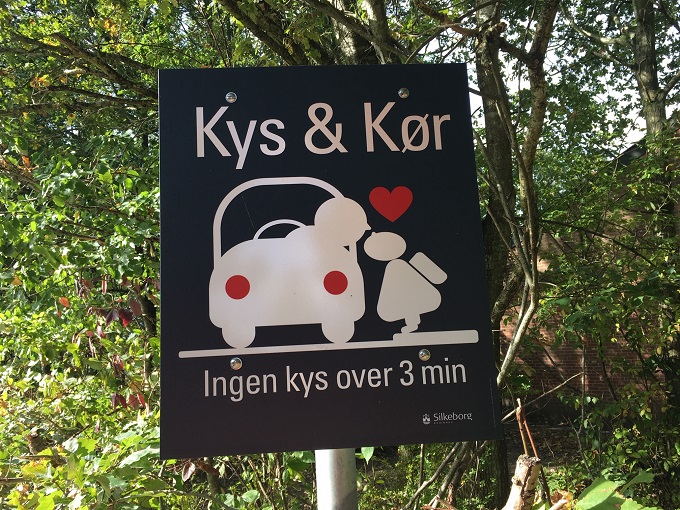
- Dropping off school children is limited to certain areas and maximum three minutes. Photo Troels Andersen
Shop owners on parking streets often want parking to be allowed since goods delivery is necessary in any case. Another option is only to allow parking for unloading of goods near relevant shops. Delivery parking should take place in specially designated bays which may be used as a pedestrian area at other times. The city of Copenhagen has tested flex areas where the parking area alternates between car parking and bicycle parking depending on the time of day. The arrangement works well near a school where bicycles are usually gone by mid-afternoon.
20 -25 cm high kerbs/concrete blocks or bollards are the option of last resort for preventing illegal stopping and parking. Bollards and high kerbs can make cyclists feel insecure and increase the risk of solo accidents against immobile objects. Therefore there must be at least 30 cm between bollards and cyclists, and traffic safety should be thoroughly scrutinized.
Economy
The following guideline experience prices may be helpful in establishing a budget for cycling measures:
| Element | Prices 2019 |
|---|---|
| Extensive traffic calming (chicanes, bumps, narrowings, etc.) | DKK 600-20,000 per rm |
| 0.3 m wide thermoplastic edge line | DKK 30-60 per rm |
| 0.1 m wide thermoplastic edge line | DKK 10-50 per rm |
| 10 bicycle symbols | DKK 3,500-5000 per 10 |
| Crossing established with continuous cycle track and pavement | DKK 60,000-150,000 |
| 2.2 m wide blue thermoplastic cycle crossing | DKK 500-800 per rm |
| Red powder asphalt | DKK300-450 per m2 |
| Road closure | DKK 5,000-100,000 |
| 1 speed bump on existing traffic lane, kerb to kerb, incl. marking | DKK 20,000-35,000 |
| 1 mini-roundabout | DKK 100,000-1,500,000. |
| Roundabout with 1 circulation lane and central island in leg | DKK 1,500,000-4,000,000 |
| Establishing cyclist slip lane around traffic light | DKK 30,000-100,000 |
| Shortening a cycle track by 30 m | DKK50,000-100,000 |
| Establishing a crossing island | DKK 50,000-250,000 |
| Establishing a bicycle signal phase at a signal controlled intersection | DKK 50,000-200,000 |
| Cycle track wayfinding incl. contractor work | DKK 2,000-10,000 per sign |


